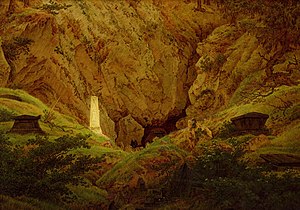Solitary Tree - Caspar David Friedrich — Google Arts & Culture
https://artsandculture.google.com › asset › solitary-tree-...
In 1822 the art patron and collector, Heinrich Wagener, commissioned a “times of day” diptych from Friedrich. The morning picture became The Solitary Tree.
8月30日下午11:26 ·

廖志峰
【史學家的耕耘】-余英時紀念論壇線上講座
聯經出版 LinkingBooks
【活動資訊】 △ 9月5日,2:00 pm - 3:30 pm 【史學家的耕耘】 講者:王汎森、陳弱水、彭國翔
////
****
Caspar David Friedrich (5 September 1774 – 7 May 1840).卡斯巴·大衛·佛烈德利赫:「從一粒砂中也可以看到自然的神妙。」
The Tombs of the Old Heroes (German - Grabmale alter Helden) is an oil on canvas painting by Caspar David Friedrich, painted between April and August 1812. It is also known as The Graves of the Fallen Freedom Fighters (Gräber gefallener Freiheitskrieger) or Arminius's Grave (Grab des Arminius). It is now in the Hamburger Kunsthalle. As its alternative titles suggest, it was produced during an era of renewed interest in Arminius and his struggle against the Romans, an era which also produced the Hermannsdenkmal.[1]
National Gallery
Caspar David Friedrich was born #OnThisDay in 1774. In 'Winter Landscape' we see a man, having cast aside his crutches, lying against a large boulder in a snowy landscape as he prays in front of a shining crucifix protected by three fir trees. This was the first painting by Friedrich, one of the principal figures of German Romantic art, to enter a British public collection when it was purchased by the Gallery in 1987: https://bit.ly/32u98mS

他迷戀的主題:死亡、憂愁、自然等。常常漫步於山林海濱,探索自然風景。他有極端敏銳的觀察力,又擅於表達光線與色彩的精微細節。
Caspar David Friedrich (5 September 1774 – 7 May 1840) was a 19th-century German Romantic landscape painter, generally considered the most important German artist of his generation.
https://en.wikipedia.org/wiki/Caspar_David_Friedrich
In his 1961 article "The Abstract Sublime", originally published in ARTnews, the art historian Robert Rosenblum drew comparisons between the Romantic landscape paintings of both Friedrich and Turner with the Abstract Expressionist paintings of Mark Rothko. Rosenblum specifically describes Friedrich's 1809 painting The Monk by the Sea, Turner's The Evening Star[86] and Rothko's 1954 Light, Earth and Blue[87] as revealing affinities of vision and feeling. According to Rosenblum, "Rothko, like Friedrich and Turner, places us on the threshold of those shapeless infinities discussed by the aestheticians of the Sublime. The tiny monk in the Friedrich and the fisher in the Turner establish a poignant contrast between the infinite vastness of a pantheistic God and the infinite smallness of His creatures. In the abstract language of Rothko, such literal detail—a bridge of empathy between the real spectator and the presentation of a transcendental landscape—is no longer necessary; we ourselves are the monk before the sea, standing silently and contemplatively before these huge and soundless pictures as if we were looking at a sunset or a moonlit night."[88][89]
A term coined c.1960 by the American art historian Robert Rosenblum (1927–2006) to characterize the feelings of vastness and solitude suggested by certain Abstract Expressionist paintings, for example those of Newman, Rothko, and Still. Newman had earlier used the word ‘sublime’ in connection with his own work (‘The Sublime is Now’, Tiger's Eye, December 1948).
Rosenblum first used the term ‘Abstract Sublime’ in print as the title of an article in the February 1961 issue of Art News, and two years later Lawrence Alloway coined the term ‘American Sublime’ to describe the same quality (‘The American Sublime’, Living Arts, June 1963). Rosenblum developed his ideas at book length in Modern Painting and the Northern Romantic Tradition: Friedrich to Rothko (1975), in which he related Abstract Expressionism to a wider western tradition of the Romantic landscape. In 1994 David Sylvester referred to the ‘cosmic grandeur’ of Newman, the ‘cosmic energy’ of Pollock, and the ‘cosmic pathos’ of Rothko.

沒有留言:
張貼留言